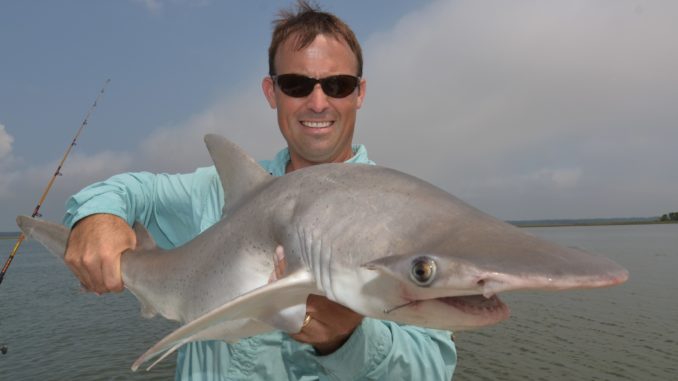
Sharks of several species are shadowing concentrations of bait just off the beach, around inlets
Hot water and hot air means spectacular shark fishing along the southern end of the Grand Strand. From black tips and spinners to bonnetheads, a wide variety of sharks is available for the avid angler, and they can be found very close to home in shallow waters. For the past few weeks, the shark fishing has been fantastic in the waters around Georgetown, and Capt. Jay Nelson of Winyah Guide Service has been right in the middle of them with rods doubled over.
“(Discovery Channel’s) Shark Week seems to always be right on track with the peak of shark fishing in our area,” said Nelson (843-817-8508), who is typically found poling the skinny waters behind North Island for reds, except that neither he nor his clients can resist the battles from powerful sharks during the summer.
“Sharks are following the bait around, and the menhaden schools are massive right now,” Nelson said. “The bait is hanging out just beyond the breakers and anywhere in proximity to the inlets. Look for birds bombing. It’s generally a giveaway for the sharks and bait down below.”
Sharks are eating machines and will devour just about any kind of fishy offering imaginable. Still, Nelson will match the hatch, using fresh or live mullet or menhaden to catch black tips and spinners.
“I use live mullet when I can to allow a good opportunity to hook up on a tarpon, too. Tarpon will frequent these same areas and can be a real bonus on a shark trip,” he said.
Bonnetheads will patrol the jetties some, but the best action for these sharks with the strange heads is just inside the inlets, along the shallow side of oyster banks near a deep-water channel. Nelson prefers live or freshly-cut blue crabs fished right along the edge of the bank, with just a few split shot on the line to keep the bait anchored along the bank. While bonnetheads rarely exceed 25 pounds, these sharks can put up an incredible fight on light tackle.
Since sharks have a mouth full of razor-sharp teeth, terminal tackle must be tough as nails. Nelson always uses at least a 4-inch section of steel leader at the end of his line where he ties a 6/0 to 8/0 circle hook for any of the shark species available. Typically, sharks feed near the bottom. Depending on the current in the inlet and along the ocean front, he will use between a 2- and 4-ounce egg sinker to keep the baits in the strike zone along the sea floor.
However, Nelson will also free-line live baits behind his boat as well. He uses a chum block at times to concentrate his targets behind the boat. Sharks will hover near the surface among the smelly bits of ground fish floating in the current, and baits placed high in the water column tend to produce more aggressive bites.
For the rest of August and well into September, anglers should expect good times battling powerful sharks along the southern end of the Grand Strand. For the bait should remain concentrated near shore and along the coastal fringe for the rest of the summer season.




Be the first to comment